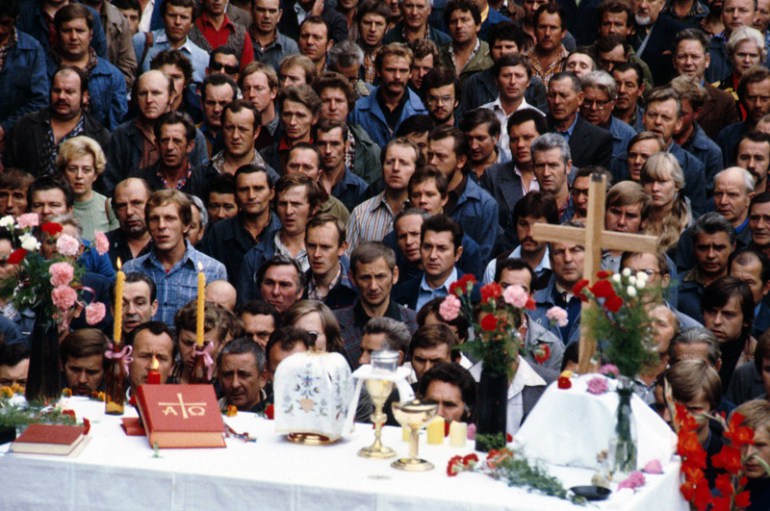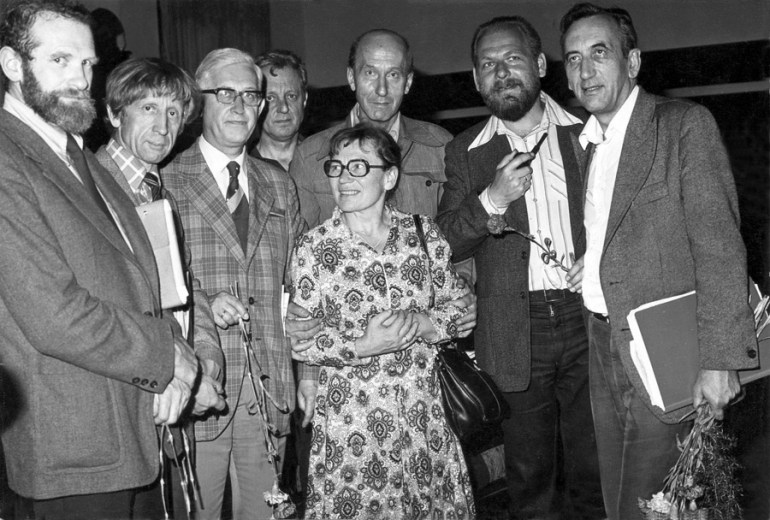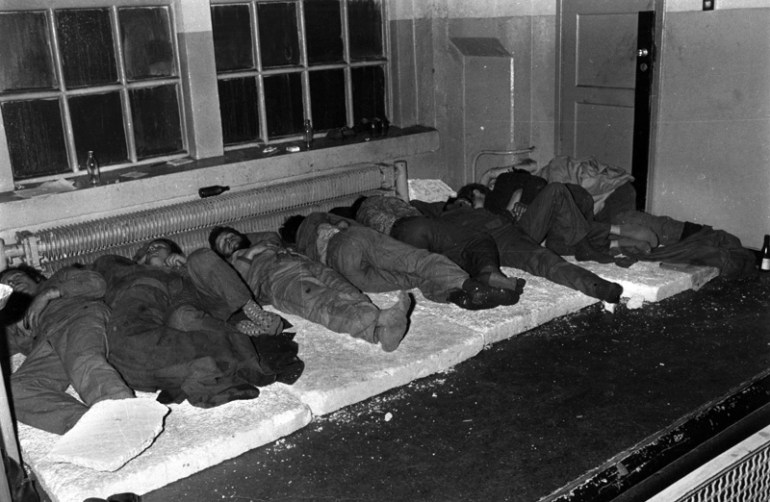Perhaps the most popular perspective on Solidarność today, including those outside of Poland, sees it as a force opposing foreign-imposed (Soviet, Russian) totalitarianism and fighting for national freedom. The radical version of this stance holds that Solidarity wanted to destroy communism and the USSR – and eventually it did. However, as one young Polish author claims, this is rather far from what Solidarity was really about. Rather than fighting the communists, Jan Sowa claims, Solidarity was more interested in reforming the regime so that it was closer to its original Marxist ideology. And at a certain point, it was even teaching the Communist Party what a truly communist system should actually be about. Can Solidarity be a lesson for all of us today?
Solidarność: The Basics
The labour union “Solidarność” was officially formed in Gdańsk on 17th September 1980 following a series of nationwide co-ordinated workers' strikes in the second half of August 1980, and negotiations with the ruling Communist Party. The strikes, which came close to paralysing the regime’s economy, were extremely effective, and helped to build an organisation that within the next 15 months grew to nearly 10 million members. At this point, it had obviously become much more than a trade union – and a real threat to a regime based to a large extent on the autocratic rule of the Communist Party.
As a result, the organisation was made illegal just a year and a half after it was formed, conveniently soon after the introduction of Martial Law in Poland. This effectively crashed Solidarność as a popular movement. Its activity was only revived in the second half of the 80s, when it became a key force behind the peaceful dismantling of the regime during round table discussions – but this time, Sowa claims in his newest book Inna Rzeczpospolita Jest Możliwa ("A Different Republic is Possible"), it was an altogether different organisation. This begs the question: what was the real nature of the first incarnation of Solidarity?
Was Religion Important in Solidarity?
 Mass in the Gdańsk Shipyard on the last day of the strike, August 1980. Photo: Chris Niedenthal / Forum
Mass in the Gdańsk Shipyard on the last day of the strike, August 1980. Photo: Chris Niedenthal / ForumOne of the popular clichés of how Solidarity is remembered and referred to, is that its formation and activity was the result of a fruitful alliance between workers and the church. When a Pole was selected as the new Pope of the Catholic church in 1979 and during his subsequent trip to Poland he pronounced the famous words “Don't be afraid!”, these acts were widely seen as a call for political boldness and empowerment. In the simplified and most radical version of this narrative, it was actually John Paul II who abolished communism.
It’s true that Catholic symbols and religious ceremonies had a strong presence in the everyday functioning of Solidarity. Holy masses were held throughout the entire strike period in Gdańsk’s shipyard, where the gates were adorned with images of the Virgin Mary, and Catholic priests, like Jerzy Popiełuszko, were quasi-chaplains of the movement. But, Sowa claims, the usage of these symbols and rituals was to a large extent pragmatic. The gates of factories were indeed covered with Catholic imagery, but this was done in the hope that Polish soldiers would not have the courage to shoot at the holy images or drive their tanks through them. The same goes for the masses held whenever the striking workers were tired and wanted to go home.
Sowa claims that it was part of Solidarity's syncretic nature to incorporate elements of different ideologies and traditions. One good example is Gate No 2 at the Gdańsk Lenin Shipyard. Although holy imagery as well as a portrait of the Pope were hanging on the gate, above them one could see a big red sign saying “Proletarians of all factories unite”, a clear reference to the communist tradition and ideology which formed the core of the strikers' worldview. For the pragmatically-inclined strikers, reconciling communism and Catholicism was no problem, argues Sowa.
Sowa also points to the fact that around the same time when the first Solidarity was active in Poland, the Catholic church launched a fierce attack on liberation theology in Latin America, an ideology which attempted to combine Marxism with Catholicism. Sowa concludes that the Marxist and anarcho-syndicalist elements present in the first Solidarity's ideology were ultimately quite distant from the Catholic church’s ideas at that time.
How About All Those Intellectuals?
 Anna Walentynowicz, a Gdańsk Shipyard worker, along with the intellectual advisers of the strike: (from left to right) Bronislaw Geremek , Tadeusz Kowalik , Jerzy Stembrowicz , Andrzej Wielowieyski , Jan Strzelecki , Bohdan Cywiński , and Tadeusz Mazowiecki. Photo: Andrzej Friszke Archive / FOTONOVA
Anna Walentynowicz, a Gdańsk Shipyard worker, along with the intellectual advisers of the strike: (from left to right) Bronislaw Geremek , Tadeusz Kowalik , Jerzy Stembrowicz , Andrzej Wielowieyski , Jan Strzelecki , Bohdan Cywiński , and Tadeusz Mazowiecki. Photo: Andrzej Friszke Archive / FOTONOVA Another popular interpretation sees Solidarność as the unlawful offspring of workers and intellectuals. While it is true that opposition intellectuals, especially those centred around KOR (the Workers' Defence Committee), like Jacek Kuroń or Adam Michnik, did play a vital part in Solidarity's activity (they were present during negotiations with the regime), their role actually became exaggerated over time.
Sowa suggests that their very different departure points made collaboration between the workers and intellectuals extremely difficult. For workers, the most important thing was their situation in factories, which they felt was best fought by forming independent labour unions. For intellectuals, the biggest problem was censorship – their fight basically centred around freedom of speech.
In fact, Sowa argues, this disconnect was at the core of many debates between workers and intellectuals. The latter repeatedly attempted to soften the demands of workers because they considered the formation of independent and self-governing labour unions as totally unrealistic under communism. In a symbolic turn of events, Solidarity was actually formed when Adam Michnik didn't make it to a meeting in Gdańsk during which he was supposed to convince the workers that this demand was pointless:
They arrested me and Jacek [Kuroń] and that's why Solidarity was formed, because otherwise we probably would have succeeded in persuading them that it had no right to be formed. We knew that independent, self-governing labour unions are not possible under communism, but the workers didn't know that. That's how Solidarity was formed, without us and against us.
In choosing what seemed an impossible utopia, workers may have had more faith than realism. But it was precisely because of this faith and relentlessness that they succeeded in forming Solidarity.
Also, the specific elements of the worker protests in 1980 to which they owed their effectiveness, like the sit-ins, inter-factory strike committees and the horizontal national union structure, had little if anything to do with the intellectuals’ inspiration. All these elements developed from the legacy of earlier worker protests, most importantly those during the 1956 Hungarian revolution and events in Poznań from that same year, as well as the bloody aftermath of the 1970 protests in Gdańsk.
The Most Communist Event Possible
 Resting workers during the sit-in at the Gdańsk Shipyard in August 1980. Photo: Zbigniew Trybek / Forum
Resting workers during the sit-in at the Gdańsk Shipyard in August 1980. Photo: Zbigniew Trybek / ForumSo what was Solidarity really about? Although it began as a workers’ organisation, Solidarność was bigger than just a trade union, as it addressed issues about the country’s structural reorganisation. In other words, it wasn't only about defending the rights of workers: it attempted to actively take control of the means of production. This is in striking contrast to the common idea that Solidarity had a pro-capitalist and pro-liberal character.
Sowa repeatedly stresses that Solidarity did not direct itself towards introducing the free market and capitalism to Poland, as is sometimes claimed today. Far from it. Solidarity, more than anything else, was an attempt at empowering workers and making them the real managers of the economy. Something the regime would smear as “an anarcho-syndicalist deviation”, but what was actually designed as an implementation of true socialism.
In fact the term “social”, as Sowa points out, is the most frequent word to appear in Solidarity’s official programme from October 1981. While words like “capitalism”, “free market” or “private ownership” hardly surface in the document, the word “social” in its different forms and combinations comes up 144 times across 60 pages. This was not a rhetoric move to outsmart the censors. The workers really wanted and demanded social enterprise, social control over the economy, and social ownership of the means of production – the last demand being, as Sowa puts it, a demand communist par excellence.
Rather than fighting the communist regime, Solidarity was interested in reforming it. This had paradoxical and deeply ironic consequences, as at one point Solidarity was actually the side addressing the Communist Party with the demand for the “real socialisation of control over the economy”. This is to say, Solidarność was teaching the party what true communism should really be about. Sowa concludes that, not only was it not an anti-Communist movement, but Solidarity was itself the most communist event possible.
Was Poland on its Way to a Different Revolution?
 Protesting workers in Gdansk Shipyard, 1980. Photo: Erazm Ciolek / Forum
Protesting workers in Gdansk Shipyard, 1980. Photo: Erazm Ciolek / ForumAt its peak during 1980 and 1981, Solidarity had close to 10 million members (at the time, the Communist Party in Poland wasn't even half that big). This makes it, as Sowa notes, possibly the biggest, voluntary organisation formed as the result of a spontaneous grassroots movement in history. By this time, it had obviously become something more than a trade union. It was now a popular workers' movement that included people of almost every possible social identity: industrial workers, intellectuals, teachers, students, writers and journalists.
The exceptional feature of this Solidarity was that it included people of all social groups. The ideology of Solidarity consciously channelled many goals into one programme, including: the defence of workers from the ubiquitous rule of the Communist Party through unions; the democratisation of social and political life; and the transformation of the means of production from state-owned to socially-owned.
This Solidarity, as Sowa puts it, was organised in an ultra-democratic, participatory manner in order to give each and every member the biggest possible control over the union's policies and actions:
If we would care to define democracy as a situation where citizens can influence the fate of their country through active participation in public life, one would have to agree with those who claim that between August 1980 and December 1981, Poland may have been the most democratic place on Earth.
This is quite a contrast to how this period is usually pictured. Obviously, this situation couldn't last long. On 13 December 1981, Martial Law was introduced and a couple of months later Solidarity was made illegal. This effectively crashed the movement in its original form. “With tanks on the streets and opposition leaders in prison, Solidarity lost its momentum and never fully recovered from the blow delivered by the military fist”, Sowa claims in his article An Unexpected Twist of Ideology. He adds:
I would say even more and claim that Poland was on its way towards a revolution in the early 1980s that, had it been fulfilled, would have dramatically reshaped power relations and the ideological landscape of Europe. It's too much to say that it would have abolished the global rule of capital, but it would not have allowed neoliberalism to triumph so ruthlessly in the 1990s, nor would Francis Fukuyama have proclaimed we had reached the end of history. It would have kept the alternative alive.
Although, as Sowa claims, Solidarity did reappear after Martial Law, it was changed. It was more and more influenced by intellectuals and other social elites which, unlike workers, were proponents of liberal ideas. This paved the way for privatisation and the switch to neoliberalism, the ideology that has marked Polish economic realities ever since the Transformation, much to the detriment of workers' position.
What About Solidarity Today?
 1988 - Strikes are back at the Gdańsk Lenin Shipyard. Photo: Jerzy Kosnik/Forum
1988 - Strikes are back at the Gdańsk Lenin Shipyard. Photo: Jerzy Kosnik/ForumWhile much of the true legacy of the first Solidarity may have been wiped out in the aftermath of Martial Law and the subsequent ideological switch to the neoliberal capitalism of the 1990s, Sowa believes that there's still a lesson to be learned from Solidarity. This goes especially for the idea of socially-controlled means of production, a concept never actually realised in the historically communist states, and something that may be gaining topicality in this era of neoliberal capitalism. At its philosophical core is the idea of the workplace as an institution of common good, and that only within this framework, as Sowa claims, can work be conceptualised as the cooperative production of wealth, namely common wealth. This democratisation of the workplace, along with the implementation of further democratic reforms of representative institutions, lies at the heart of “Another Commonwealth”, the project proposed by Sowa in his book.
Jan Sowa's book Inna Rzeczpospolita jest możliwa! Widma przeszości i wizje przyszłości was published in April 2015, by WAB publishing house.
Author: Mikołaj Gliński, 17 September 2015.